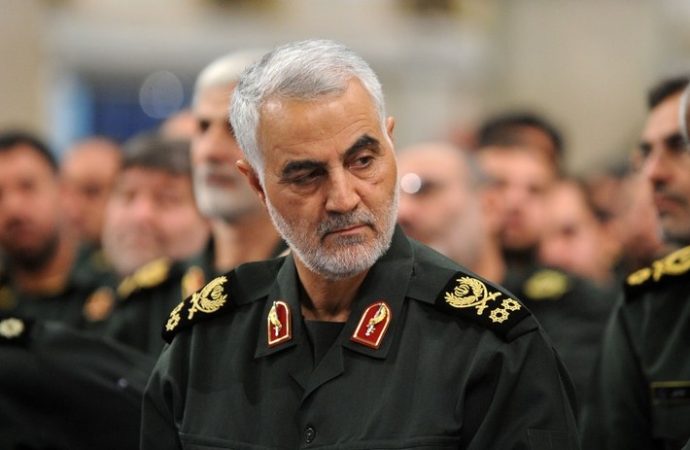Killing Suleimani: the tricky business of predicting what comes next
 The killing of Iranian General Qassem Suleimani has triggered the writing of a plethora of op-eds and think-pieces. Many of these make bold predictions without, in fact, providing a great deal of factual basis to support them. In reality, it is impossible to forecast the course of events going forward; it is critical to understand decision making within the Iranian system is a complex and opaque process involving a range of important actors. Thus, regardless of the confidence of most media-pundits in their own conclusions, predicting what happens next is far from easy.
The killing of Iranian General Qassem Suleimani has triggered the writing of a plethora of op-eds and think-pieces. Many of these make bold predictions without, in fact, providing a great deal of factual basis to support them. In reality, it is impossible to forecast the course of events going forward; it is critical to understand decision making within the Iranian system is a complex and opaque process involving a range of important actors. Thus, regardless of the confidence of most media-pundits in their own conclusions, predicting what happens next is far from easy.
Within a day of the killing of Qassem Suleimani, the head of the Quds Force (QF) of the Islamic Revolutionary Guards Corps (IRGC), a virtual cottage industry of predictions of “what comes next” has sprung up. Not surprisingly, left-wing and liberal pundits offered grim scenarios of Iran’s revenge reaction with the potential to ignite a general war. Even those who agreed that Suleimani was responsible for destabilizing the region through his extensive militia network and killing hundreds of thousands, including American service members, felt that the risk of provoking Iran was too high. Indeed, these and other commentators mentioned that both the Bush and the Obama administrations have passed up on several opportunities to take out the master-terrorist.
Conservative and security hardliners did not dismiss the danger of provoking Tehran but argued that the risk was worth taking given the destructive role that Suleimani had played in Lebanon, Iraq, Syria and Yemen. At the very least, in this view, targeting him during the American surge in Iraq in 2007 would have prevented the enterprising QF chief from striking a pact with Russia to prevent the collapse of the Assad regime in Syria.
These pundits noted that the United States had plenty of military and cyber capabilities to respond to all Iranian provocations, including mining of the Straits of Hormuz during the Iran-Iraq war. For those who believe in the power of deterrence, Operation Praying Mantis in April 1988 serves as a template. In response to an Iranian mine which damaged USS Samuel B. Roberts President, Reagan ordered a strike in which two Iranian oil rigs were destroyed as well as and about half of its small navy. In July, after considerable pressure from the IRGC, Ayatollah Khomeini, the Supreme Leader, declared that he was willing to drink the “poisoned chalice” and ended the war with Iraq.
While it is impossible to forecast the course of events triggered by the death of Suleimani, it should be pointed out that predictions which assume that Iran is a unitary actor are conceptually flawed. The regime is composed of three sectors: the state sector that includes the government and the bureaucracy, the parastatal sector where the IRGC and its affiliates dominate, and the Supreme Leader’s network, the so-called Rahbar’s Office. Suleimani, with the support of Ayatollah Ali Khamenei, had assumed control of Iran’s revolutionary export and foreign policy in the Middle East. In contrast, President Rouhani and the Foreign Ministry presides over relations with Europe and the rest of the world.
After President Trump withdrew from the Joint Comprehensive Plan of Action (JCPOA) in May 2018, an intense debate on how to respond to the new sanctions ensued within the Rahbar’s Office and the Guards. Suleimani urged to defy the United States and promised to exhaust the “Great Satan” through a series of pinpoint actions such as disruption of marine traffic in the Persian Gulf and attacks on Saudi Arabia. Ali Jafari, an IRGC commander, considered this strategy too risky but was sidelined. Hossein Salami, who cultivated an aggressive anti-American stand, was picked to fill the post on April 21, 2019. Soon after, Iran launched several high-profile operations like attacking oil tankers in the Gulf waters or shooting down the US drone and attacking Saudi oil infrastructure.
Trump’s failure to respond to Iran’s provocations cemented Suleimani’s status as a military genius who could take on the most powerful country in the world with impunity. Both the Supreme Leader and the QF commander mocked Trump as a coward, and a so-called “chicken heart” (Bozdel). Suleimani was also convinced that Trump would not risk a major conflict during an election year, a view associated with Tucker Carlson, a Fox News personality close to the president. By his own admission, Carlson warned Trump that he would lose the 2020 election in the eventuality of a war with Iran.
Acting upon this assumption, Suleimani ordered the Shite militias in Iraq to increase its assaults on American targets in Iraq. During the past three months alone, US military bases and its diplomatic mission were subject to five rocket attacks. The widespread protest in Lebanon, Iraq and Iran itself, however, put Suleimani on the defensive, especially in Iraq where Shite militias were accused of killing hundreds of civilian protesters.
To create a public relations diversion the QF chief ordered Kataib Hezbollah (KH) a small but a fiercely loyal militia, to carry out more assaults on American targets, according to a Reuters report. In one such attack, an American contractor was killed, prompting Trump to authorize a retaliatory strike on a KH camp that killed 25 fighters. To up the ante, Suleimani authorized an assault on the American embassy in Baghdad where KH militia members burned the reception area and inflicted other damage. On January 3, President Trump approved a strike which killed Suleimani and the commander of the KH, Abu Mahdi al-Muhandis.
Sources close to the White House reported that the president was given several options and some of his aides were surprised that he chose to take out the powerful QF commander. Commentators were quick to point out that Trump’s decision-making is erratic and temperamental, that he was “angered” by Suleimani, and struck out without a plan to handle the fallout. Given the president’s past performance, this assumption is not out of the realm of the possible. Still, there might have been some rationality in the calculus in the sense that Trump tried to avoid the fate of Carter who lost the election after the Iranians seized the American embassy in Tehran in 1979 and held the diplomats in captivity for 444 days.
Whatever Trump’s motivation, Tehran is left in a conundrum about how to respond. By failing to react, the Islamic Republic would lose prestige in the region and beyond. However, a strong retaliation could pose an existential danger to the regime already beset by economic problems that sparked the recent popular protest. It is also not clear whether Suleimani’s successor, Ismael Ghani, who has neither the charisma nor the extensive personal connection of his former boss, is up to the job. The anti-Iranian sentiment in Lebanon and Iraq have also been a source of considerable worry. How to weight these concerns would be the subject of a decisive debate in the Revolutionary Guards and the Supreme Leader circles that may sharpen the division between the pro-Jafari and pro-Suleimani camp.
Dr. Farhad Rezaei is a member of ASMEA and author of Iran, Revolution, and Proxy Wars.
The opinions expressed here are their own.
Read the original post on the Centre for International Policy Studies blog.




